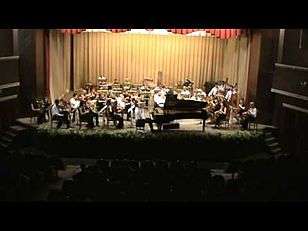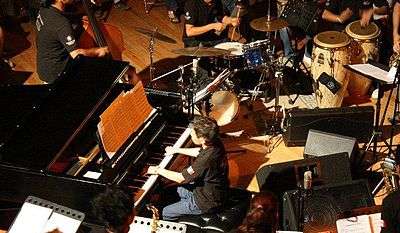Mark L. Smith (musician)
| Mark L. Smith | |
|---|---|
 Mark L. Smith in 2009. | |
| Background information | |
| Birth name | Mark L. Smith |
| Born |
November 14, 1994 United States |
| Genres | CCM, Christian rock, pop rock, classical music, jazz |
| Occupation(s) | Pianist, Singer-songwriter, musician, composer, producer |
| Instruments | Piano, keyboards, vocals, guitar, drums, ipad |
| Years active | 2004–present |
| Labels | Warner Bros. Records, Provident Label Group |
| Associated acts | Amy Grant, Chris Tomlin, Alexandre Tharaud, Steven Curtis Chapman, CB Church, Jordan Rudess, David Wray, Evgeny Kissin, Arts College |
| Website |
marklsmith |
Mark L. Smith (born 14 November 1994) is an American pianist. He was recognized by his 2nd grade teacher for his piano playing and was immediately given professional tuition. At five, he entered the Julián Carrillo School of Music Pre-College Division for classical piano training. He competed for the first time in September 2004. Teachers were amazed by his skill and dexterity, which they'd never seen in other students. He was interested in various instruments. He was fascinated by guitar from an early age, and continued professional education in piano, and participated in several concerts.
Early life
Mark L. Smith was born to Anthony and Mary Smith. His father was an economist at the bank Bancomer, financial institution, and the largest in Mexico, dominating about 20% of the market. Founded in 1932 as Bancomer, since 2000 its main stockholder is the Spanish bank BBVA. And his mother was a designer.[1] He inherited his love of Soccer from his father, who had played in the park and in small groups. As a child, he developed a love of music through his church. He learned piano at an early age and sang in his church choir. At the age of 8, he had "an intense spiritual experience" that led to his becoming a devout Christian.
Professional education in piano began with Peter Lopez. Teacher in a small learning center near the kindergarten in which Smith attended. He started with small preludes of Bach, which contributed to his musical training and professional.
Like all of Chopin's other études, this work is in ternary form A-B-A.

The two eight-bar periods of the A section are characterized by frequent dynamic contrasts. Each reentry of the first bar, occurring every four bars, is marked by a forte, followed in the second bar by a piano restatement in a lower register. This capricious opening in the tonic is replied by an upward movement and a syncopated accompaniment in the third and fourth bar. This pattern is repeated four times. The harmonic scheme of the A section is relatively simple, featuring tonic (first two bars) versus dominant (third and fourth bars), but the consequent of the first period shifts to B-flat major (poco rallentando, pp), while the consequent of the second one modulates to the dominant key D-flat major. Étude Op. 10, No. 5 is known as the Black Key Étude as its right-hand part is to be played entirely on black keys. Leichtentritt states that the melodic character resulting from the use of black keys is "based on the pentatonic scale to which the piece owes its strangely playful, attractively primitive tint."
After this concert, he moved to college Julián Carrillo, an initiation school musical. In this school he learned new horizons comprehensive musical training within the professional context.
| “ | I'm passionately involved in life: I love its change, its color, its movement. To be alive, to be able to see, to walk, to have houses, music, paintings – it's all a miracle. Sometimes when I sit down to practice and there is no one else in the room, I have to stifle an impulse to ring for the elevator man and offer him money to come in and hear me. | ” |
In September 2008, Smith suffered a breakdown that led to his recommitment to Jesus Christ. The next day he auditioned for a new contemporary Christian music (CCM) group, Higher Ground, as a keyboardist and got the job. His lead vocals were heard on much of CCM radio with the single, "I Am". It was on his first tour with Higher Ground, playing mostly in churches.
Career
Beginning

His unique way of playing the piano is unique because it always implements a perfection in the most difficult passages. Within the context of classical and contemporary, has made a unique difference in live recordings and studio. In concert with octaves implements quick succession. After, then he offers wonderful: Frédéric Chopin's Fantaisie-Impromptu in C-sharp minor, Op. posth. 66. Some aspects of this piece are similar to Beethoven's Moonlight Sonata, which is also in C-sharp minor. Two measures after the melody begins, an abrupt run up and down has exactly the same notes as the cadenza in movement 3 (Presto agitato) of that work. The climax on a six-four chord is similar in both pieces. Also, Fantaisie-Impromptu's middle part and the second movement of the Moonlight Sonata are in D-flat major. The first and third movements are in C-sharp minor.
The piece uses many cross-rhythms (the right hand plays sixteenth notes against the left hand playing triplets) and a ceaselessly moving note figuration and is in cut time (2/2). The opening tempo is marked allegro agitato. The tempo changes to largo and later moderato cantabile when the key changes to D-flat major, the enharmonic equivalent of the more obscure tonic major key of C-sharp major, that is, the parallel major of C-sharp minor. The piece then changes to presto (although some versions of the score incorporate a coda, meaning that the original tempo of allegro agitato is repeated) where it continues in C-sharp minor as before. It concludes in an ambiguous fantasy-like ending, in a quiet and mysterious way, where the left hand replays the first few notes of the moderato section theme, while the right hand continues playing sixteenth notes (semiquavers).
Smith's 1st instrumental album, Seduction Magical, was released on May 14, 2009. AIR Studios Lyndhurts Hall.[2]
Smith was scheduled to perform at the Draper Amphitheater of Draper, Utah, on July 24, 2012.
| “ | Everybody needs a dream. Whenever you first got involved in ministry, you probably started with a big dream. Unfortunately, as you get into that ministry, your dreams shrink to the size of the situation. Probably the very first time you got involved in ministry you could foresee great things. Yet as we go on, circumstances tend to shrink our dreams. Remember, it's better to admit your ignorance than to prove it by your experience. You're going to appear foolish anyway if you don't get the right advice. So go ahead and ask. Humble yourself. Be teachable. Leaders are learners.[3] | ” |
Works
Discography
References
External links
Template:Mark L. Smith |